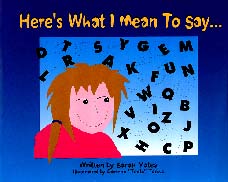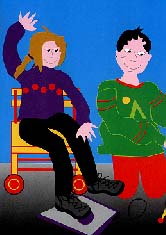|
________________
CM . . . .
Volume VII Number 15 . . . . March 30, 2001
Yates uses Ann's voice to convey what it is like to have CP. She states simply: "It means I can tell
my arms and legs what to do but they don't listen. I can't speak either but I've got lots of words
inside my head." Ann is confined to her "rolling chair" and needs the help of her parents and
teacher aide to do things other children take for granted. Her perseverence as well as her
frustrations, and those of the people who care for her, are revealed in Ann's matter-of-fact voice.
She describes her experiences in mastering her speaking computer and her excitement as she
realizes its potential. Ann is also preoccupied by her upcoming birthday, as her mother plans to
have a hat decorating party and Ann worries that Jay will find it too feminine. Ann is not able to
explain this to her mother, nor to ask Jay himself. When she can finally use her computer to tell
her mother she doesn't want a hat party, her sense of accomplishment is profound.
Illustrator Toews, a graphic designer, has also collaborated with Yates on two previous books
about Ann. She uses bold colours on edge-to-edge backgrounds, often blending different colours
from top to bottom (eg. from pink to yellow). Her figures are two-dimensional with cartoon faces
that convey an minimal amount of emotion.
The author, whose daughter has CP, wanted to provide a role model for children with disabilities
and an advocate for those children. Ann does indeed fill that role. She is a likeable child who gets
great joy from life and uses humour in her interactions with others. There is no plea for sympathy
here, only a honest portrayal of Ann's day-to-day life, and it is by comparison that children will see
the enormity of her daily challenges and victories.
Recommended.
Alison Mews is head of the Curriculum Materials Centre in the Faculty of Education, Memorial
University of NF, St. John's, NF.
To comment on this title or this review, send mail to cm@umanitoba.ca.
Copyright © the Manitoba Library Association.
Reproduction for personal use is permitted only if this copyright notice
is maintained. Any other reproduction is prohibited without
permission.
Published by
TABLE OF CONTENTS FOR THIS ISSUE - March 30, 2001.
AUTHORS |
TITLES |
MEDIA REVIEWS |
PROFILES |
BACK ISSUES |
SEARCH |
ORDER |
CMARCHIVE |
HOME
|

 With some notable exceptions, children's stories with a disabled child as main character often have
that child become a hero by solving a problem in a unique way and thus winning acceptance by
his/her peers. This artificial ploy to promote tolerance is not favoured here. In this story of a
nine-year-old girl with cerebral palsy, we hear how her life was dramatically changed when she
received a computer that could vocalize for her. While the story is firmly rooted in her physical
condition, the focus is on her relationships with her parents and her best friend, Jay.
With some notable exceptions, children's stories with a disabled child as main character often have
that child become a hero by solving a problem in a unique way and thus winning acceptance by
his/her peers. This artificial ploy to promote tolerance is not favoured here. In this story of a
nine-year-old girl with cerebral palsy, we hear how her life was dramatically changed when she
received a computer that could vocalize for her. While the story is firmly rooted in her physical
condition, the focus is on her relationships with her parents and her best friend, Jay.